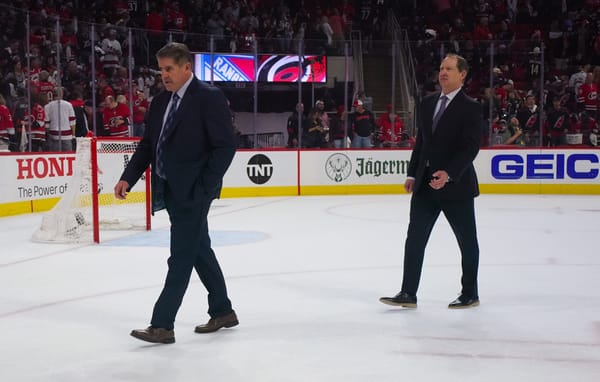2017 Rangers Report Card: Nick Holden
The New York Rangers acquired Nick Holden from the Colorado Avalanche in exchange for a fourth-round pick at the 2016 NHL Entry Draft – making the 2016-17 season his first in New York.
The left-handed defenseman showed his ability to play on both sides, giving him more versatility in the lineup if needed. During the regular season, he was featured on a number of pairs – most often on the right side of the second pair with Marc Staal (677.59 minutes at 5v5). Along with Staal, he saw minutes with Ryan McDonagh (161.75 minutes), Brendan Smith (161.37 minutes), Kevin Klein (144.08), Brady Skjei (108.25 minutes), and Dan Girardi (65.05 minutes).
In the 80 regular season games that the 30-year-old defenseman played, he scored 34 points (11 goals, 23 assists) which ranked third amongst Ranger defenders. Holden also accumulated the most hits for (150 at 5v5) of the defense, he recorded 19 takeaways and blocked 72 shots (averaging 0.9 per game). Conversely, he also led the defense in giveaways with 53, which was the second-highest on the team.
Interestingly enough, Holden also led Rangers defenders in 5v5 time on ice with 1359.74 minutes played. Despite scoring 34 points, with Holden on the ice the Rangers’ production was not particularly overwhelming. Of the defensemen that skated for the Blueshirts this season (McDonagh, Girardi, Staal, Skjei, Smith, Klein, Adam Clendening, and Steven Kampfer), Holden had the third lowest Corsi for per 60 (51.89) that quantifies the team’s shot attempts for with him on the ice.
In terms of scoring chances for Holden was middle of the pack (8.65 per 60), and among defenders, he was fourth lowest in expected goals for (2.46 per 60). However, he was on the ice for the second-highest goals for (60 overall, 2.65 per 60) among Rangers defenders.
Holden’s weakness this season was his defensive play – as he could frequently be found making high-risk offensive plays that would leave the Rangers open defensively, hesitating between making a play and blocking a shot, or impeding on goaltender Henrik Lundqvist’s ability to make a save. And far too often, he could be found reading a play incorrectly, which would result in him over committing in a certain area and leaving his teammates and goaltender vulnerable.
Of the Rangers’ defensemen, Holden was on the ice for the second highest shot attempts against (1303) and based on his ice-time the fourth-most against (57.5 per 60). He also was on the ice for the most scoring chances against (212, 9.35 per 60) which was the second highest of the blueliners. Holden’s expected goals against (61.2, the highest on defense; 2.7 per 60) also reflected his defensive shortcomings.
Holden appeared in 11 of the Rangers 12 playoff games, as he was scratched one game in favor of Klein. In those games, he scored four points (two goals, two assists) – all of which were at 5v5. He again led the Rangers defenders in hits for (37 at 5v5). Additionally, he had three takeaways, seven giveaways, and 18 blocked shots.
In the playoffs, Holden’s offensive contributions varied. He was on the ice for the second-most shot attempts for (59.41 per 60) and fewest scoring chances for (8.49 per 60). Additionally, he was also on the ice for six goals for (the second lowest, 2.04 per 60) and earned an expected goals for per 60 of 2.46 (second highest).
On the other side of the ice, he was on the ice for a number of shot attempts against (62.12 per 60), a few scoring chances against (5.43 per 60), and the most goals against (8, which translated to 2.72 per 60).
The same defensive tendencies that plagued him in the regular season were blatantly seen in the postseason as well. In Game 2 against the Montreal Canadiens, Holden was on the ice for all three goals regulation goals against – including the game-tying goal in the final 17 seconds that sent the Canadiens to overtime, where they were victorious.
Then in Game 2 against the Ottawa Senators, Holden was on the ice for the most high-danger chances and scoring chances against. In double overtime, Holden pinched on the play and the Senators found an opportunity to capitalize on – leaving Staal to defend a 2-on-1 himself. The Senators scored on that chance and put themselves ahead in the series 2-0.
As much as Holden is to blame for how he performed in his role, the onus was on the coaches to deploy him properly. In Game 2 against the Canadiens, for example, it was Vigneault that purposely skipped the pair of Skjei and Smith in the rotation in favor of Holden and Staal – which ultimately cost the Rangers the game.
Having said that, the onus is also on Holden to adjust his game accordingly when his team is struggling because of his defensive liabilities – especially since he made the same costly mistakes several times throughout the year. It was also Holden’s responsibility to also adjust his game when the partner he played with for the majority of the season struggled because of his high-risk plays. At some point, Holden needed to course correct, but he showed an inability or unwillingness to make changes to better his game.
With all of that in mind, Holden’s scored an overall grade of a C in his first season in New York.
*All data is at 5v5 via Corsica.hockey




